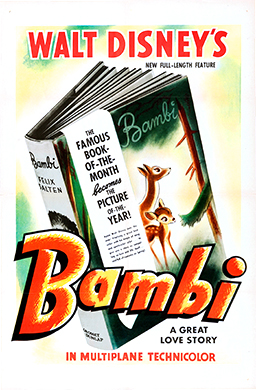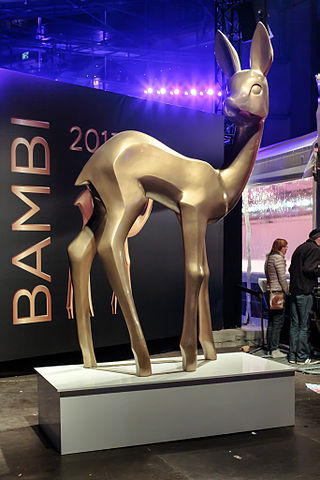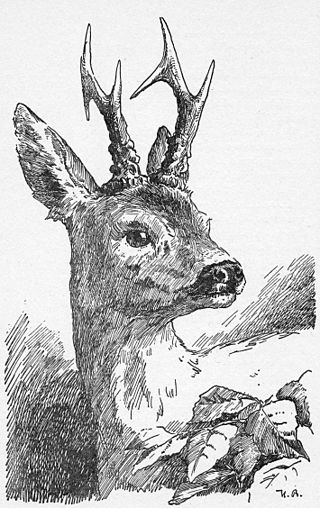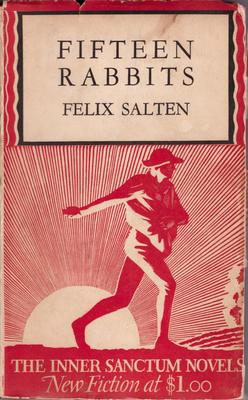
Bambi, a Life in the Woods is a 1923 Austrian coming-of-age novel written by Felix Salten, and originally published in Berlin by Ullstein Verlag. The novel traces the life of Bambi, a male roe deer, from his birth through childhood, the loss of his mother, the finding of a mate, the lessons he learns from his father, and the experience he gains about the dangers posed by human hunters in the forest. It is also, in its most complete translation, seen as a parable of the dangers and persecution faced by Jews in Europe.

Felix Salten was an Austro-Hungarian author and literary critic in Vienna.

The Shaggy Dog is a 1959 American fantasy comedy film produced by Walt Disney Productions and loosely based on the 1923 novel The Hound of Florence by Felix Salten. Directed by Charles Barton from a screenplay by Lillie Hayward and Bill Walsh, the film stars Fred MacMurray, Tommy Kirk, Jean Hagen, Kevin Corcoran, Tim Considine, Roberta Shore, and Annette Funicello. The film follows a teenage boy named Wilby Daniels who, by the power of an enchanted ring of the Borgias, is transformed into a shaggy Old English Sheepdog.

Bambi is a 1942 American animated drama film produced by Walt Disney Productions and released by RKO Radio Pictures. It is based on the 1923 novel Bambi, a Life in the Woods by Austrian author and hunter Felix Salten. The film was produced by Walt Disney and directed by David Hand and a team of sequence directors.

Eleanore Cammack "Cammie" King was an American actress and public relations officer. She is best known for her portrayal of Bonnie Blue Butler in Gone with the Wind (1939). She also provided the voice for the doe Faline as a fawn in the animated Disney film, Bambi (1942).

Josephine Mutzenbacher or The Story of a Viennese Whore, as Told by Herself is an erotic novel first published anonymously in Vienna, Austria, in 1906. The novel is famous in the German-speaking world, having been in print in both German and English for over 100 years and sold over 3 million copies, becoming an erotic bestseller.

Bambi II is a 2006 American animated drama film directed by Brian Pimental and produced by the Australian office of Disneytoon Studios as a followup to the 1942 film Bambi. Animation production was done by DisneyToon Studios Sydney, Australia. It premiered in theaters in Argentina on January 26, 2006, before being released as a direct-to-video title in the United States on February 7, 2006.

The Bambi, often called the Bambi Award and stylised as BAMBI, is a German award presented annually by Hubert Burda Media to recognize excellence in international media and television to personalities in the media, arts, culture, sports, and other fields "with vision and creativity who affected and inspired the German public that year", both domestic and foreign. First held in 1948, it is the oldest media award in Germany. The trophy is named after Felix Salten's book Bambi, A Life in the Woods and its statuettes are in the shape of the novel's titular fawn character. They were originally made of porcelain until 1958, when the organizers switched to using gold, with the casting done by the art casting workshop of Ernst Strassacker in Süßen.

Bambi is the title character in Felix Salten's 1923 novel, Bambi, a Life in the Woods, and its sequel, Bambi's Children. The character also appears in Salten's novels Perri and Fifteen Rabbits.

Thumper is a fictional rabbit character from Disney's animated film Bambi (1942). He is known and named for his habit of thumping his left hind foot. The young adult version of Thumper also appears at the Walt Disney Parks and Resorts as a meetable character in Fantasyland and at Disney’s Animal Kingdom.

Perri: The Youth of a Squirrel is a 1938 novel by Felix Salten, author of the 1923 novel Bambi, a Life in the Woods, and is a followup to that book. Its title character is a Eurasian red squirrel. Bambi makes a brief appearance in Perri.
Kurt Wiese was a German-born book illustrator, who wrote and illustrated 20 children's books and illustrated another 300 for other authors.

The Hound of Florence: A Novel is a 1923 novel written by Felix Salten. It is best known today for partly inspiring the 1959 Walt Disney Productions film The Shaggy Dog as well as its sequels and remakes. The novel was first translated into English in 1930 by Huntley Paterson, and the translation has illustrations by Kurt Wiese.

Fünf Minuten Amerika is a 1931 travel book by the Austrian writer Felix Salten, depicting his tour of 1930 in the United States of America. This is his second travel book, following his account of Palestine, Neue Menschen auf alter Erde, of 1925. Salten himself considered these two books to be his foremost.

Renni the Rescuer: A Dog of the Battlefield is a 1940 war novel by Felix Salten, describing the career of a military working dog called Renni, a German Shepherd dog, and his master, Georg.

Djibi, the Kitten is the last novel of Felix Salten, published originally in 1945 and translated into English in 1946. Similarly as in other Salten's late books, the protagonist is an animal, this time a young female cat called Djibi.

The Shaggy Dog franchise consists of American science fiction-fantasy-comedy films, with three theatrical releases, and two made-for-television films. The overall story is based on the 1923 novel titled The Hound of Florence by Felix Salten. The overarching story of each installment, follows Wilbur "Wilby" Daniels who is cursed and transforms into a large Old English Sheepdog after attaining an ancient Borgian ring and reciting its inscription.

Fifteen Rabbits is a 1929 survival and adventure novel by the Austrian writer Felix Salten. The novel depicts a year in the life of a colony of rabbits in the same forest where Bambi dwells.

Maurice "Jake" Day was an American artist, sculptor, photographer, naturalist and illustrator. He is best known for creating the fawn-like character of Bambi for the 1942 animated Walt Disney feature film Bambi.

Florian: The Emperor's Stallion, also published as Florian: An Emperor's Horse and Florian the Lipizzaner, is a 1933 novel by the Austrian writer Felix Salten, made in 1940 to the film Florian. The novel tells the story of a Lipizzan horse during and after the decline of the Hapsburg monarchy in Vienna, circa 1901–1930.



















